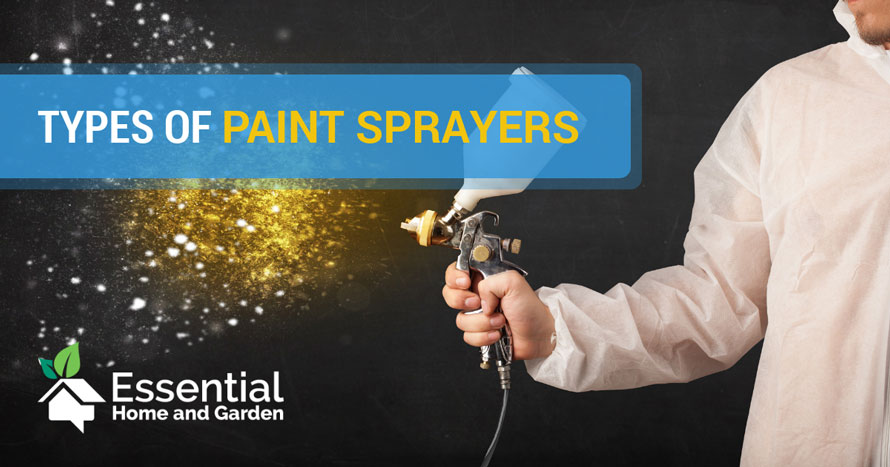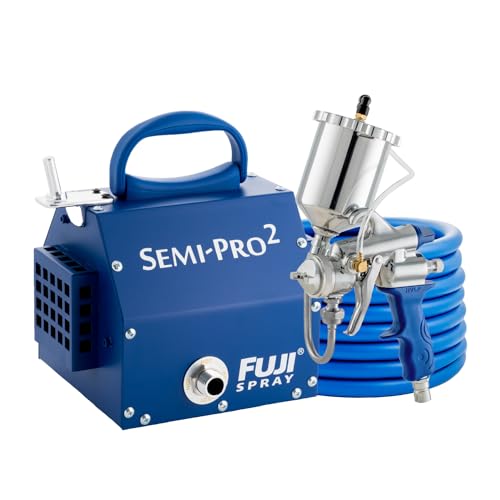Do you have a large surface area to paint? Perhaps you want to avoid the unsightly brush strokes that become embedded into the finish when dry? Maybe you need to get a paint job completed quickly, and don’t have the time for multiple coats?
You need a paint sprayer.
A paint sprayer allows you to apply an even coating of paint in a fraction of the time it takes to administer with a brush or a roller.
Perhaps you need to respray your car? A brush is never going to do the job.
There’s a variety of powered paint sprayers available – it can be a little confusing to know which is the best for your particular job. So, with no further ado, we’ll help you decide which paint sprayer is right for you and the perfect applicator for your specific situation.
3 Different Types Of Paint Sprayers
The main options are airless, compressed air, and HVLP. The type you require depends on the kind of job and your level of expertise.
Each type contains a reservoir for your chosen paint, as well as a method of propelling the liquid from the container and through the tip of the sprayer.
Airless Paint Sprayers
Airless paint sprayers propel the paint through the tip of the sprayer using an electric pump, applying extremely high pressure to the paint reservoir. The paint is forced through the tip of the sprayer which fans minute droplets which stick to your desired surface; drying with a glass-smooth finish.
The airless sprayer is available with a variety of tips suitable for various paint jobs, such as:
- wood stain
- varnish
- lacquer
- more viscous liquids such latex house paint.
As with all paint sprayers, extreme care and caution should be employed when using airless systems. You should keep your skin away from the gun tip, as it can inject paint into your skin; releasing potentially dangerous toxins into your bloodstream.
PROs
The pressure sprayer usually works directly from the paint tin or a 5-gallon bucket. With a little practice, you can achieve a perfect finish, making airless paint sprayers particularly effective for large paint jobs around the home and garden.
If you’re looking for a professional finish with a quick learning curve, airless sprayers could be your instrument of choice.
CONs
The droplets sprayed through the nozzle don’t necessarily all end up sticking to your desired surface. Some of the paint drifts through the air, causing between 20-40% wastage. It might be quick, it’s not always the most economical application method. You should mask off surrounding areas thoroughly to keep them paint free.
Painting outdoors is particularly risky, as there’s more likely to be a stronger breeze – you could end up with psychedelic shrubs, or a neighbor’s car might take on a new rainbow tinge; extreme caution is recommended.
Compressed Air Sprayers
Compressed air paint sprayers project the paint out of the tip using compressed air, creating a smooth and even finish. Compressed air systems are probably the most simple to use, so are perfect for novices – they’re literally foolproof.
When using compressed air systems, it’s essential to wear eye protectors and a respirator mask – you don’t want to inhale any paint that doesn’t land on your desired surface.
A typical compressed air sprayer set-up includes a spray gun attachment, a high-pressure hose, and a compressor canister.
You connect your spray gun to the air compressor via the high-pressure hose, which contains a regulator, determining the amount of airflow (in cubic feet per minute) required to propel your chosen paint from the container. Your paint will often require a little by-hand preparation – mixing the paint with a solvent to achieve the appropriate consistency for the gun you’re using.
You should try the paint mix and air pressure on a piece of cardboard before you apply any paint to your furniture or walls. This will give you an opportunity to experiment with the right air pressure to help you control the flow; providing the required finish.
PROs
If you need to paint a cabinet or similar-sized item of furniture, compressed air distribution is a great option.
Perhaps less versatile than the airless sprayer, people often choose compressed air for the ease of use. Compressed air systems are usually cheaper to buy or rent.
CONs
Compressed air sprayers aren’t particularly economical to run – they use a lot of paint and require an air compressor to operate.
HVLP Paint Sprayer
HVLP stands for High Volume Low Pressure. This system uses a steady volume of air to propel the paint from the tip of the gun onto your desired surface. HVLP sprayers are popular because the lower pressure is easier to control, creating less mess or waste.
HVLP systems are generally only recommended for thinner paints – latex-style paints require an airless sprayer. However, industrial HVLP sprayers handle more viscous liquids, but they’re more expensive to buy or rent.
HVLP sprayers use a compressor (or turbine) to atomize the paint. Most models allow you to adjust the pressure of the spray so that you can attend to more delicate surfaces or difficult corners.
PROs
In comparison with an airless spray system, an HVLP kit will cost you considerably less. The lower pressure makes HVLP perfect for smaller, interior jobs such as doors and walls. Because of the variable pressure settings, HVLP is the most versatile of the other distribution methods and is much safer to use than the higher pressure delivery systems.
CONs
As mentioned, most HVLP systems can handle only thinner paints – so is perfect for wood stain and primer, for example, but not recommended for latex or gloss paints.
Paint Sprayer Cleaning
Cleaning can be time-consuming, regardless of the chosen method of propulsion. It’s essential that you leave no trace of paint in the pipes, gun, or pump, to avoid blockages.
If you’re using oil-based paints, it can take a gallon or two of paint solvent to get the machine completely clear.
The Bottom Line
The type of job you need to execute should be a significant consideration if you’re considering purchasing or hiring a paint sprayer.
If you’re a complete beginner and are looking for a more professional finish for interior paint jobs around the home, then HVLP might be the system for you.
If you have large spaces to paint quickly and with a professional finish, airless sprayers are best – but they take a little practice to perfect.
For smaller jobs with a higher pressure system, then compressed air is the popular choice and requires less by way of skill.



